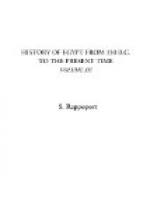Then comes a brief biography of the Rosetta Stone itself, as follows: “This stone was found by the French in 1798 among the ruins of Fort St. Julian, near the Rosetta mouth of the Nile. It passed into the hands of the British by the treaty of Alexandria, and was deposited in the British Museum in the year 1801.” There is a whole volume of history in that brief inscription, and a bitter sting thrown in, if the reader chance to be a Frenchman. Yet the facts involved could scarcely be suggested more modestly. They are recorded much more bluntly in a graven inscription on the side of the stone, which runs: “Captured in Egypt by the British Army, 1801.” No Frenchman could read those words without a sinking of the heart.
The value of the Rosetta Stone depended on the fact that it gave promise, even when originally inspected, of furnishing a key to the centuries-old mystery of the hieroglyphics. For two thousand years the secret of these strange markings had been forgotten. Nowhere in the world—quite as little in Egypt as elsewhere—had any man the slightest clue to their meaning; there were even those who doubted whether these droll picturings really had any specific meaning, questioning whether they were not merely vague symbols of esoteric religious import and nothing more. And it was the Rosetta Stone that gave the answer to these doubters, and restored to the world a lost language and a forgotten literature.
The trustees of the British Museum recognised that the problem of the Rosetta Stone was one on which the scientists of the world might well exhaust their ingenuity, and they promptly published a carefully lithographed copy of the entire inscription, so that foreign scholarship had equal opportunity with British to try to solve the riddle. How difficult a riddle it was, even with this key in hand, is illustrated by the fact that, though scholars of all nations brought their ingenuity to bear upon it, nothing more was accomplished for a dozen years than to give authority to three or four guesses regarding the nature of the upper inscriptions, which, as it afterwards proved, were quite incorrect and altogether misleading. This in itself is sufficient to show that ordinary scholarship might have studied the Rosetta Stone till the end of time without getting far on the track of its secrets. The key was there, but to apply it required the inspired insight—that is to say, the shrewd guessing power—of genius.
The man who undertook the task had perhaps the keenest scientific imagination and the most versatile profundity of knowledge of his generation—one is tempted to say, of any generation. For he was none other than the extraordinary Dr. Thomas Young, the demonstrator of the vibratory nature of light.




